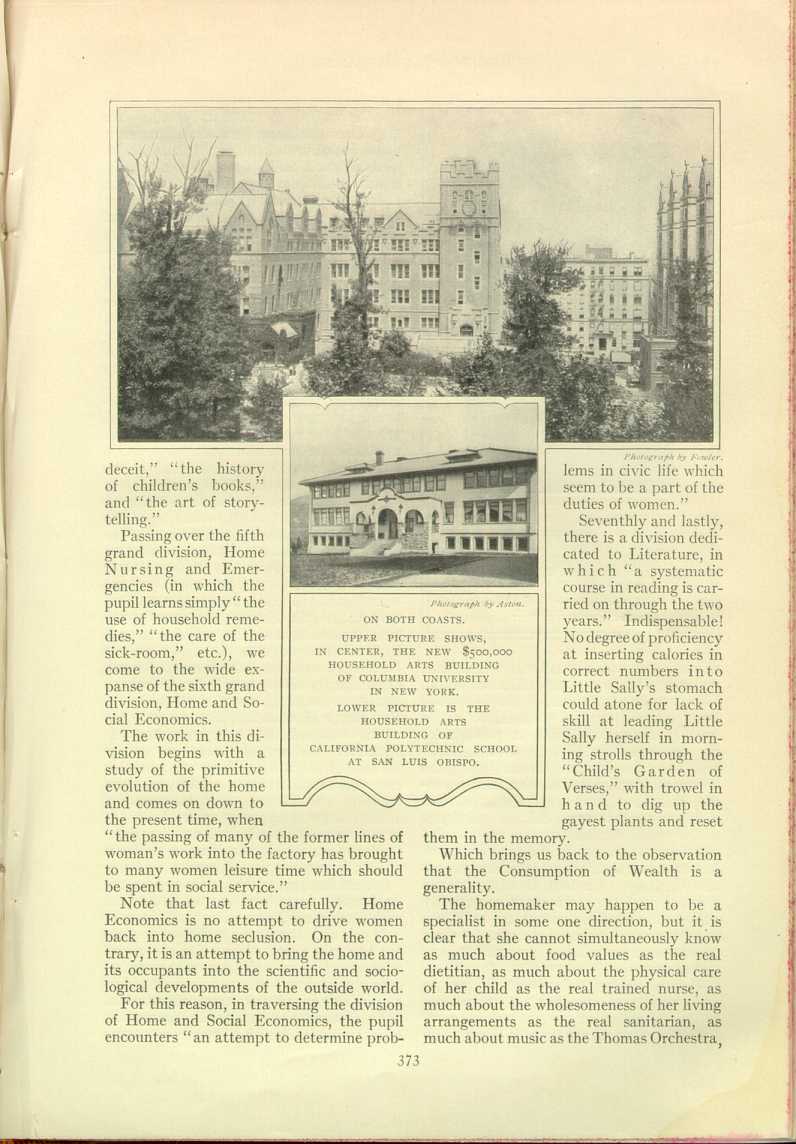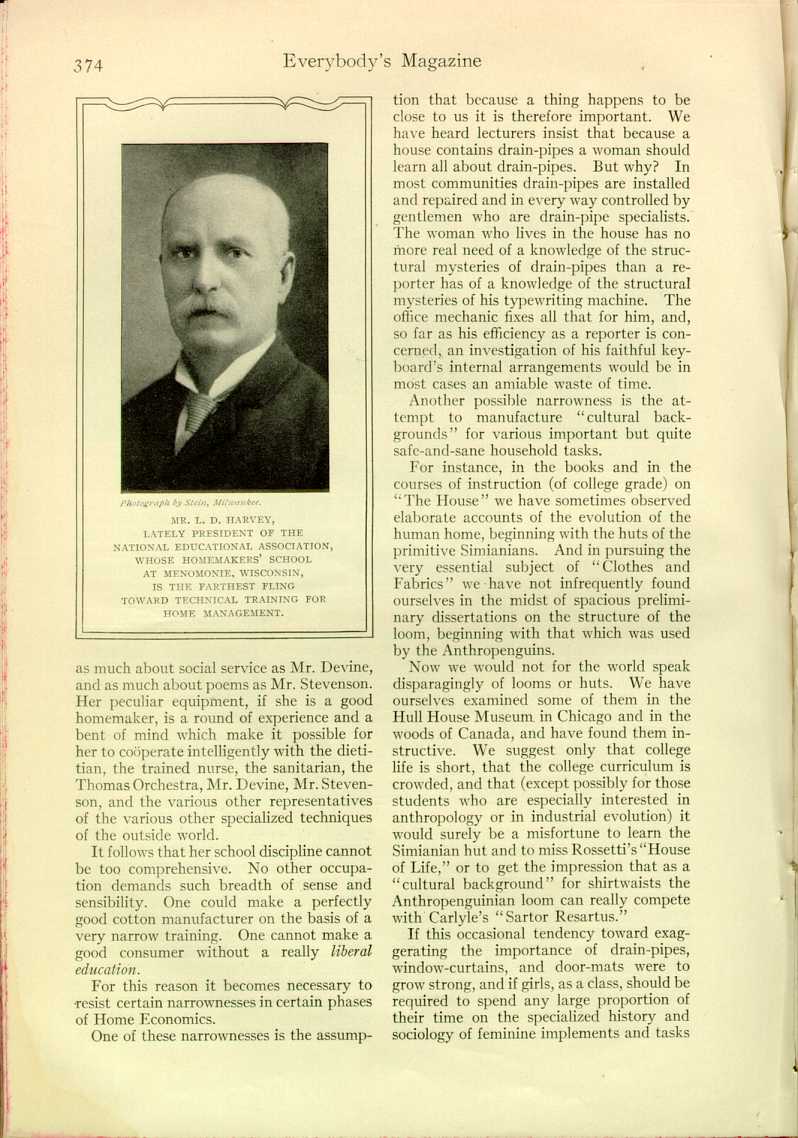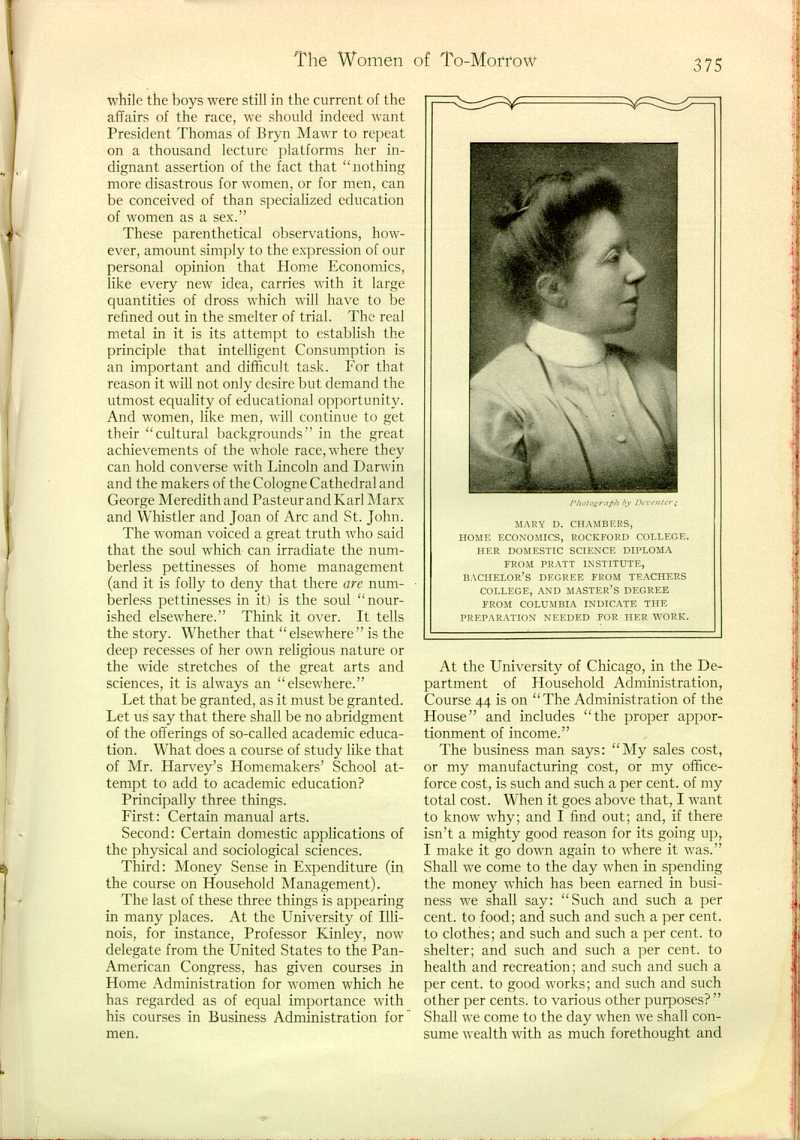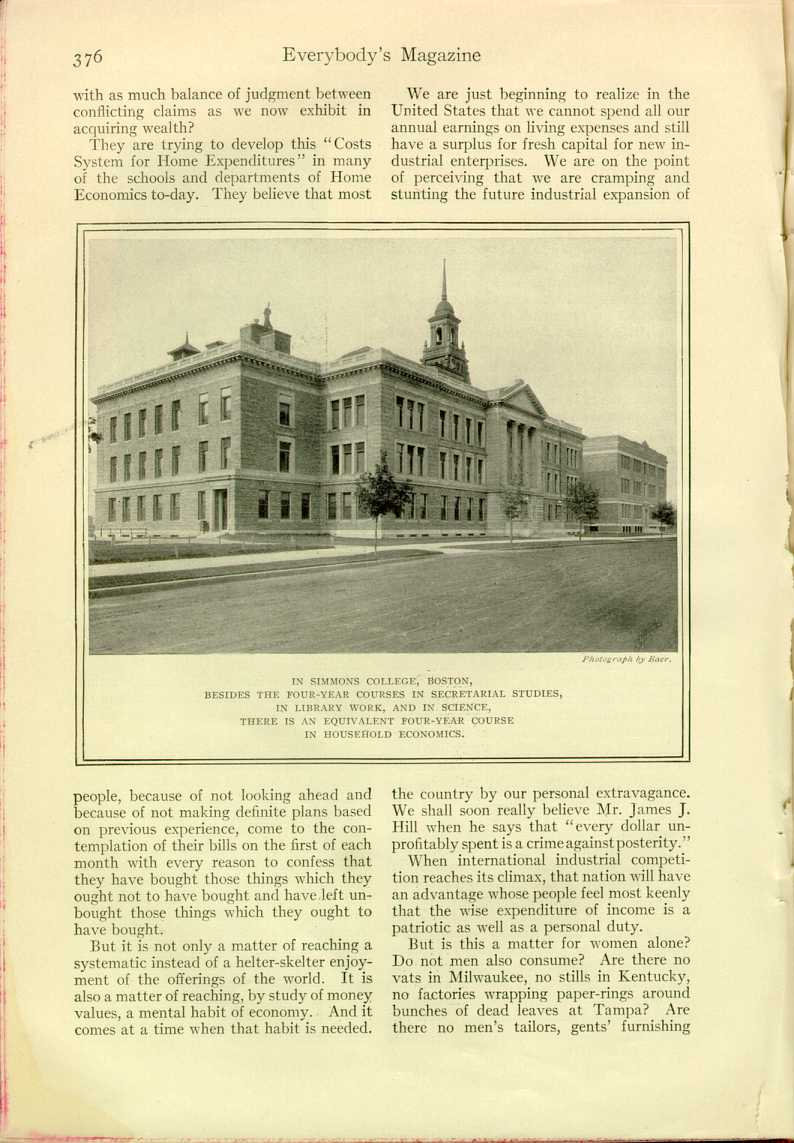| The Women of Tomorrow | ||
III
AT Menomonie, Wisconsin, Mr. L. D. Harvey, lately president of the National Education Association, has established a Homemakers' School. It does not turn out teachers. Its course of instruction is solely for the prospective housewife.
The first grand division of study is The House.
We here observe that the housewife is going to be something of a Sanitary Engineer, since she studies Chemistry, Physics, and Bacteriology in their "application to such subjects as the heating, lighting, ventilation, and plumbing of a house." It is thought that knowledge of this sort "will go a long way toward improving the health conditions of the country."
We also observe that the housewife is going to be something of an Interior Decorator, since she studies "design, color, house planning and furnishing."
She also acquires some skill as Purchasing Agent, Bookkeeper, and Employer of Labor when she takes the course on Household Management and studies "the proper apportioning of income among the different lines of home expenditures, the systematizing and keeping of household accounts, and the question of domestic service."
The second grand division is Food Study and Preparation.
Here the housewife becomes, to some extent, a Dietitian, studying "the chemical processes in the preparation and digestion of foods," and considering the question "how she shall secure for the family the foods best suited to the various activities of each individual."
Here, likewise, she makes a start toward being a Pure Food Expert, through a study of "physical and chemical changes induced in food products by the growth of molds, yeasts, and bacteria," and a start toward being a Health Officer, through a study of "bacteria in their relation to disease, sources of infection, personal and household disinfection."
Nor does she omit to acquire some of the technique of the Physical Director through a course in Physiology bearing on "digestion, storage of energy, rest, sleep, exercise, and regularity of habits."
Of course, in her work in cookery, she pays some attention to special cookery for invalids.
The third grand division, that of Clothing and Household Fabrics, produces a Dressmaker, a Milliner, and an Embroiderer, as well as a person trained to see to it that "the expenditure for clothing shall be correct in proportion to the expenditure for other purposes."
The fourth grand division, the Care of Children, is of course limitless. The rearing of the human young is, as we all know and as Mr. Eliot of Harvard has insisted, the most intellectual occupation in the world. Here the homemaker applies all the knowledge she has gained from her study of the hygiene of foods and of the hygiene of clothes, and also makes some progress toward becoming a Trained Nurse and a Kindergartner by means of researches into "infant diseases and emergencies," "the stages of the mental development of the child," "the child's imagination with regard to truth-telling and

Photograph by Aston.
ON BOTH COASTS.
UPPER PICTURE SHOWS, IN CENTER, THE NEW $500,000
HOUSEHOLD ARTS BUILDING OF COLUMBIA UNIVERSITY
IN NEW YORK.
LOWER PICTURE IS THE HOUSEHOLD ARTS
BUILDING OF CALIFORNIA POLYTECHNIC SCHOOL
IN SAN LUIS OBISPO.
[Description:
Photograph of the Household Arts building at Columbia University, inset
with a photograph of the Household Arts building at California
Polytechnic School.
]
Passing over the fifth grand division, Home Nursing and Emergencies (in which the pupil learns simply "the use of household remedies," "the care of the sick-room," etc.), we come to the wide expanse of the sixth grand division, Home and Social Economics.
The work in this division begins with a study of the primitive evolution of the home and comes on down to the present time, when "the passing of many of the former lines of woman's work into the factory has brought to many women leisure time which should be spent in social service."
Note that last fact carefully. Home Economics is no attempt to drive women back into home seclusion. On the contrary, it is an attempt to bring the home and its occupants into the scientific and sociological developments of the outside world.
For this reason, in traversing the division of Home and Social Economics, the pupil encounters "an attempt to determine problems in civic life which seem to be a part of the duties of women."
Seventhly and lastly, there is a division dedicated to Literature, in which "a systematic course in reading is carried on through the two years." Indispensable! No degree of proficiency at inserting calories in correct numbers in to Little Sally's stomach could atone for lack of skill at leading Little Sally herself in morning strolls through the "Child's Garden of Verses," with trowel in hand to dig up the gayest plants and reset them in the memory.
Which brings us back to the observation that the Consumption of Wealth is a generality.
The homemaker may happen to be a specialist in some one direction, but it is clear that she cannot simultaneously know as much about food values as the real dietitian, as much about the physical care of her child as the real trained nurse, as much about the wholesomeness of her living arrangements as the real sanitarian, as much about music as the Thomas Orchestra,

Photograph by Stein, Milwaukee.
MR. L. D. HARVEY, LATELY PRESIDENT OF THE
NATIONAL EDUCATIONAL ASSOCIATION WHOSE HOMEAKERS' SCHOOL
AT MENOMONIE, WISCONSIN, IS THE FARTHEST FLING
TOWARD TECHNICAL TRAINING FOR HOME MANAGEMENT.
[Description:
Photographic portrait of L. D. Harvey.
]
It follows that her school discipline cannot be too comprehensive. No other occupation demands such breadth of sense and sensibility. One could make a perfectly good cotton manufacturer on the basis of a very narrow training. One cannot make a good consumer without a really liberal education.
For this reason it becomes necessary to resist certain narrownesses in certain phases of Home Economics.
One of these narrownesses is the assumption that because a thing happens to be close to us it is therefore important. We have heard lecturers insist that because a house contains drain-pipes a woman should learn all about drain-pipes. But why? In most communities drain-pipes are installed and repaired and in every way controlled by gentlemen who are drain-pipe specialists. The woman who lives in the house has no more real need of a knowledge of the structural mysteries of drain-pipes than a reporter has of a knowledge of the structural mysteries of his typewriting machine. The office mechanic fixes all that for him, and, so far as his efficiency as a reporter is concerned, an investigation of his faithful keyboard's internal arrangements would be in most cases an amiable waste of time.
Another possible narrowness is the attempt to manufacture "cultural backgrounds" for various important but quite safe-and-sane household tasks.
For instance, in the books and in the courses of instruction (of college grade) on "The House" we have sometimes observed elaborate accounts of the evolution of the human home, beginning with the huts of the primitive Simianians. And in pursuing the very essential subject of "Clothes and Fabrics" we have not infrequently found ourselves in the midst of spacious preliminary dissertations on the structure of the loom, beginning with that which was used by the Anthropenguins.
Now we would not for the world speak disparagingly of looms or huts. We have ourselves examined some of them in the Hull House Museum in Chicago and in the woods of Canada, and have found them instructive. We suggest only that college life is short, that the college curriculum is crowded, and that (except possibly for those students who are especially interested in anthropology or in industrial evolution) it would surely be a misfortune to learn the Simianian hut and to miss Rossetti's "House of Life," or to get the impression that as a "cultural background" for shirtwaists the Anthropengruinian loom can really compete with Carlyle's "Sartor Resartus."
If this occasional tendency toward exaggerating the importance of drain-pipes, window-curtains, and door-mats were to grow strong, and if girls, as a class, should be required to spend any large proportion of their time on the specialized history and sociology of feminine implements and tasks
These parenthetical observations, however, amount simply to the expression of our personal opinion that Home Economics, like every new idea, carries with it large quantities of dross which will have to be refined out in the smelter of trial. The real metal in it is its attempt to establish the principle that intelligent Consumption is an important and difficult task. For that reason it will not only desire but demand the utmost equality of educational opportunity. And women, like men, will continue to get their "cultural backgrounds" in the great achievements of the whole race, where they can hold converse with Lincoln and Darwin and the makers of the Cologne Cathedral and George Meredith and Pasteur and Karl Marx and Whistler and Joan of Arc and St. John.
The woman voiced a great truth who said that the soul which can irradiate the numberless pettinesses of home management (and it is folly to deny that there are numberless pettinesses in it) is the soul "nourished elsewhere." Think it over. It tells the story. Whether that "elsewhere" is the deep recesses of her own religious nature or the wide stretches of the great arts and sciences, it is always an "elsewhere."
Let that be granted, as it must be granted. Let us say that there shall be no abridgment of the offerings of so-called academic education. What does a course of study like that of Mr. Harvey's Homemakers' School attempt to add to academic education?
Principally three things.
First: Certain manual arts.
Second: Certain domestic applications of the physical and sociological sciences.
Third: Money Sense in Expenditure (in the course on Household Management).
The last of these three things is appearing in many places. At the University of Illinois, for instance, Professor Kinley, now delegate from the United States to the Pan-American Congress, has given courses in Home Administration for women which he has regarded as of equal importance with his courses in Business Administration for men.
At the University of Chicago, in the Department of Household Administration, Course 44 is on "The Administration of the House" and includes "the proper apportionment of income."
The business man says: "My sales cost, or my manufacturing cost, or my office force cost, is such and such a per cent. of my total cost. When it goes above that, I want to know why; and I find out; and, if there isn't a mighty good reason for its going up, I make it go down again to where it was." Shall we come to the day when in spending the money which has been earned in business we shall say: "Such and such a per cent. to food; and such and such a per cent. to clothes; and such and such a per cent. to shelter; and such and such a per cent. to health and recreation; and such and such a per cent. to good works; and such and such other per cents. to various other purposes?" Shall we come to the day when we shall consume wealth with as much forethought and
They are trying to develop this "Costs System for Home Expenditures" in many of the schools and departments of Home Economics to-day. They believe that most people, because of not looking ahead and because of not making definite plans based on previous experience, come to the contemplation of their bills on the first of each month with every reason to confess that they have bought those things which they ought not to have bought and have left unbought those things which they ought to have bought.
But it is not only a matter of reaching a systematic instead of a helter-skelter enjoyment of the offerings of the world. It is also a matter of reaching, by study of money values, a mental habit of economy. And it comes at a time when that habit is needed.
We are just beginning to realize in the United States that we cannot spend all our annual earnings on living expenses and still have a surplus for fresh capital for new industrial enterprises. We are on the point of perceiving that we are cramping and stunting the future industrial expansion of the country by our personal extravagance. We shall soon really believe Mr. James J. Hill when he says that "every dollar unprofitably spent is a crime against posterity."
When international industrial competition reaches its climax, that nation will have an advantage whose people feel most keenly that the wise expenditure of income is a patriotic as well as a personal duty.
But is this a matter for women alone? Do not men also consume? Are there no vats in Milwaukee, no stills in Kentucky, no factories wrapping paper-rings around bunches of dead leaves at Tampa? Are there no men's tailors, gents' furnishing
The Massachusetts legislature has passed a law looking toward the teaching of Thrift in the public schools. Boys and girls need it equally. And we venture to surmise that in so far as the new art and science of Consumption is concerned with wise spending, the bulk of its teachings ultimately will be enjoyed by both sexes. It will not be, to any great extent, a specialized education for women.
So much for the "Money Sense in Expenditure" which a full Home Economics course adds to "academic" education. The more we admit its value, the more convinced we must be that it ought to include every kind of expenditure and both kinds of human being.
A precisely similar conviction arises with regard to those "domestic applications of the physical and sociological sciences" which a full Home Economics course adds to an "academic" education.
Those "domestic" applications are most of them broadly "human" applications. They bear on daily living, exercise, fresh air, personal cleanliness, diet, sleep, the avoidance of contagion, methods of fighting off disease, general physical efficiency. They all amount to what Mrs. Ellen H. Richards calls Right Living. She would have four R's instead of three: Reading, Riting, Rithmetic, and Right Living.
Now is Right Living to be only for girls?
Mr. Eliot of Harvard does not think so. In a recent "Survey of the Needs of Education," he said:
"Public instruction in preventive medicine must be provided for all children and the hygienic method of living must be taught in all schools. . . . To make this new knowledge and skill a universal subject of instruction in our schools, colleges, and universities is by no means impossible—indeed, it would not even be difficult, for it is a subject full of natural history as well as social interest. . . . American schools of every sort ought to provide systematic instruction on public and private hygiene, diet, sex hygiene, and the prevention of disease and premature death, not only because these subjects profoundly affect human affections and public happiness, but because they are of high economic importance."
A large part of Home Economics is simply Living Conditions. It is simply the lessons of Bacteriology, Chemistry, Physiology, and Sociology about the common facts of daily physical and social existence.
It may very well be, therefore, that what Mr. Eliot had in mind will not only come to pass but will even exceed his expectations. It may very well be that the educational policy of the future was correctly search-lighted by Miss Henrietta I. Goodrich (who used to direct the Boston School of Housekeeping before it was merged into Simmons College) when she said:
"We need to have courage to break the present courses in household arts and domestic science into their component parts and begin again on the much broader basis of a study of living conditions. Our plea would be this: that instruction in the facts of daily living be incorporated in the state's educational system from the primary grades through the graduate departments of the universities, with a rank equal to that of any subject that is taught, as required work for both boys and girls."
We revert now finally to the "manual arts" which a full course in Home Economics adds to an "academic" education. In this matter, just as in the matter of Money Sense in Expenditure and in the matter of Right Living, we observe that the ultimate issue of the movement is not so much a specialized education for women as a practical efficiency in the common things of life for men and women both.
A reasonable proficiency in manual arts will some day be the heritage of all educated people. Mr. Eliot, in his "Survey of the Needs of Education," speaks appreciatingly of his father's having caused him to learn carpentry and wood-turning. He goes on to say:
"This I hold to be the great need of education in the United States—the devoting of a much larger proportion of the total school time to the training of the eye, ear, and hand."
It follows, then, that cooking and sewing for girls in the elementary schools must be made just as rigorous a discipline for eye and hand as wood-working is for boys. It even follows that boys and girls will often get their manual training together.
It will not be a case of "household drudgery" for the girls while the boys are studying civics.
Somewhere in this article (and as close to this paragraph as we can get the Art Director to put it) the reader will find a picture of the "living room" of the "model" house of the Washington-Allston Elementary School in Boston. The boys and girls of graduating grade in that school give four hours a week to matters connected with the welfare of that house. They have furnished it throughout with their own handiwork, the girls making pillow-cases, wall-coverings, window-curtains, etc., and the boys making chairs, tables, cupboards, etc. Succeeding classes will furnish it again. The reason why Mr. Crawford, the master of the school, chose to have a house for a manual training laboratory was simply that a house offers ampler opportunities than any other kind of place for instruction in the practical efficiencies of daily living for both sexes.
The system will be complete when the girls get a bigger training in design by making more of the chairs, and when the boys get a bigger training in diet by doing more of the cooking.
| The Women of Tomorrow | ||

